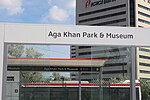Flemingdon Park

Flemingdon Park is a middle-class district and community in Toronto, Ontario, Canada, located in the city's North York district. It is part of the Don Valley East federal and provincial electoral districts, and Ward 26: Don Valley East (South) municipally. In 2011, its population was 22,205. The average income was $66,784.It is bordered on the north by Eglinton Avenue East, on the west by the Don River (west branch), and on the east and south by the Don River (east branch). The two branches of the river join at the neighbourhood’s southwest corner. The south border is a parkland access road that used to be known as Old Lawrence Avenue. Flemingdon Park is separated from neighbouring communities by river valleys on three sides, and a light industrial area, now mostly used as corporate offices, next to several railway lines on the north side. The community is named after its original owner, Robert John Fleming, the Mayor of Toronto in 1892–1893 and 1896–1897, and the nearby Don River.
Excerpt from the Wikipedia article Flemingdon Park (License: CC BY-SA 3.0, Authors, Images).Flemingdon Park
Gateway Boulevard, Toronto
Geographical coordinates (GPS) Address Nearby Places Show on map
Geographical coordinates (GPS)
| Latitude | Longitude |
|---|---|
| N 43.713 ° | E -79.334 ° |
Address
Shoe Repair
Gateway Boulevard
M3C 1T2 Toronto (North York)
Ontario, Canada
Open on Google Maps











